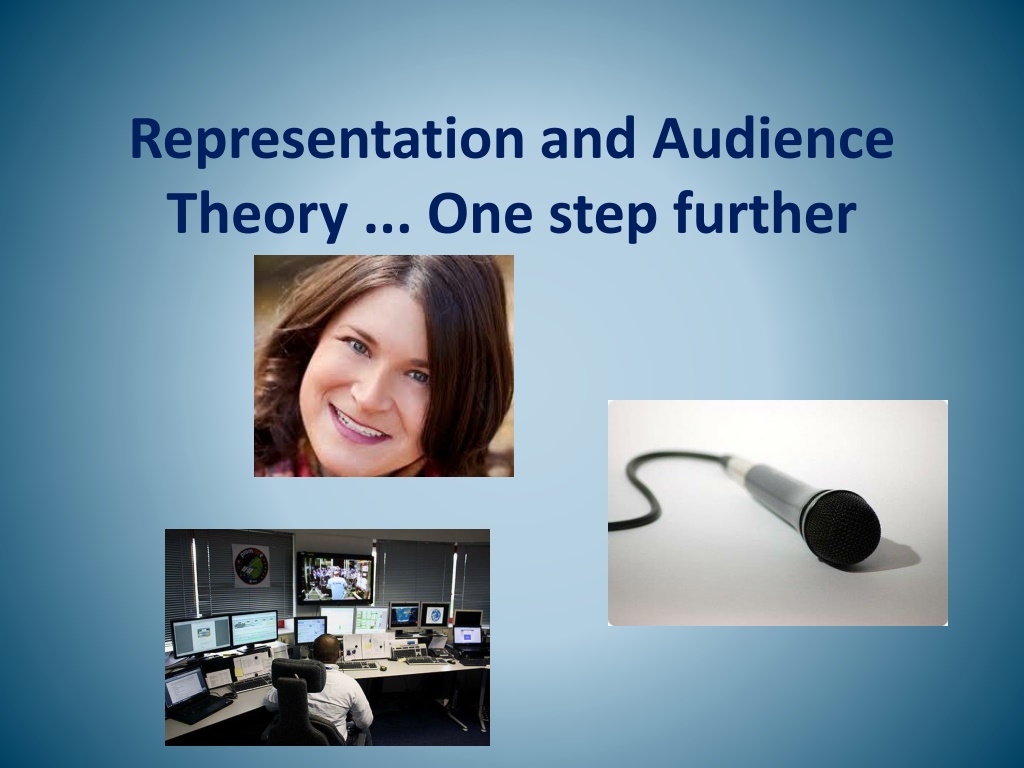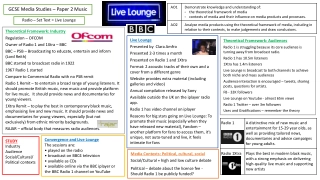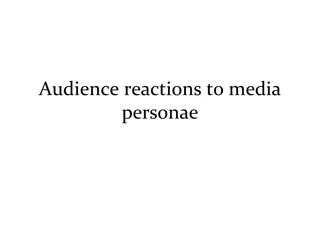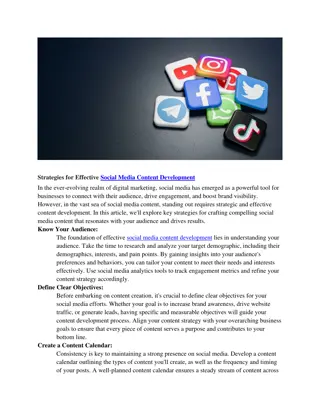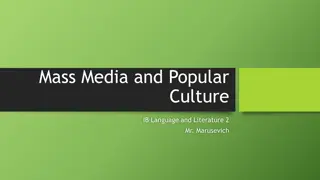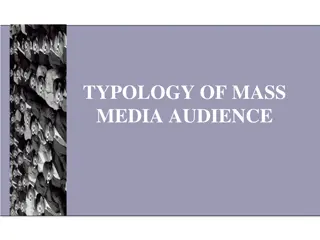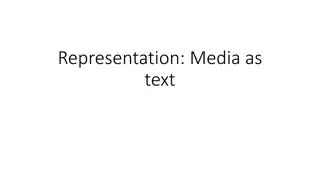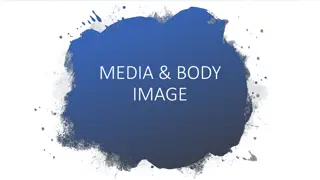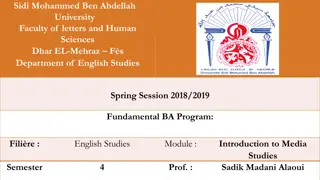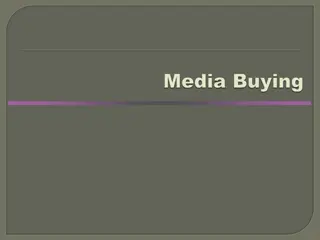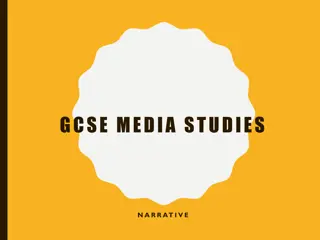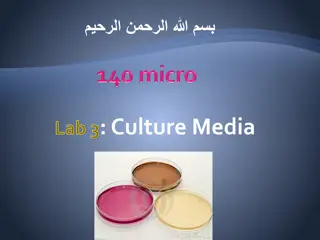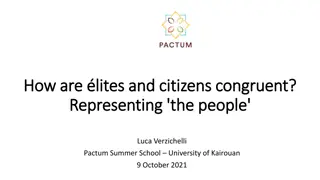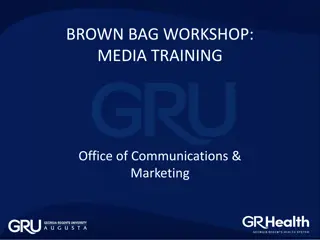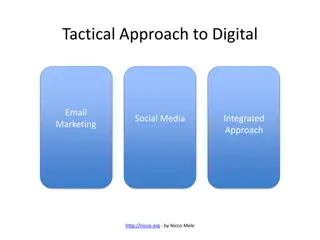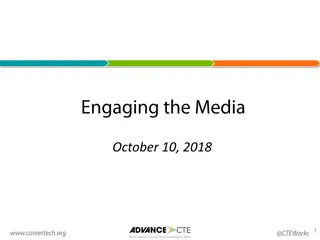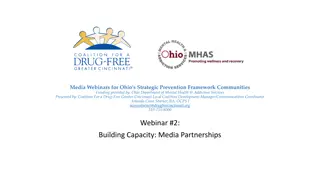Understanding Representation and Audience Theory in Media Studies
Representation and Audience Theory in Media Studies delve into how aspects of reality such as people, places, objects, and cultural identities are constructed and presented in various mediums, especially mass media. Through analysis of media products, viewers can grasp the difference between media representations and actual reality, highlighting the importance of interpretation and the processes involved in creating and receiving these representations.
Uploaded on Oct 09, 2024 | 0 Views
Download Presentation

Please find below an Image/Link to download the presentation.
The content on the website is provided AS IS for your information and personal use only. It may not be sold, licensed, or shared on other websites without obtaining consent from the author. Download presentation by click this link. If you encounter any issues during the download, it is possible that the publisher has removed the file from their server.
E N D
Presentation Transcript
Representation and Audience Theory ... One step further
Media Representation Theory Representation refers to the construction in any medium (especially the mass media) of aspects of reality such as people, places, objects, events, cultural identities and other abstract concepts. Such representations may be in speech or writing as well as still or moving pictures.
What does 'representation' mean? The easiest way to understand the concept of representation is to remember that watching a TV programme is not the same as watching something happen in real life. All media products re-present the real world to us; they show us one version of reality, not reality itself. So, the theory of representation in Media Studies means thinking about how a particular person or group of people are being presented to the audience.
Media Representation Theory The term refers to the processes involved as well as to its products. For instance, in relation to the key markers of identity - Class, Age, Gender and Ethnicity (the 'cage' of identity) - representation involves not only how identities are represented (or rather constructed) within the text but also how they are constructed in the processes of production and reception.
Representation and gaze Who is doing the looking? How do men look at images of women? How do women look at images of men? How do men look at images of men? How do women look at images of women?
Representations as constructions A key concern in the study of representation is with the way in which representations are made to seem natural . All texts, however 'realistic' they may seem to be, are constructed representations rather than simply transparent 'reflections', recordings, transcriptions or reproductions of a pre-existing reality. However, representations which become familiar through constant re-use come to feel 'natural' and unmediated.
Representations are judged Representations require interpretation - we make judgements about them based upon our own experiences and backgrounds.
Representation involves selection Representation is unavoidably selective, foregrounding some things and back grounding others.
Key Questions about Specific Representations What is being represented? How is it represented? Using what codes? Within what genre? How is the representation made to seem 'true', 'commonsense' or 'natural'? What is foregrounded and what is backgrounded? Are there any notable absences?
Key Questions about Specific Representations Whose representation is it? Whose interests does it reflect? How do you know? At whom is this representation targeted? How do you know? What does the representation mean to you? What does the representation mean to others? How do you account for the differences? How do people make sense of it? According to what codes? With what alternative representations could it be compared? How does it differ?
Television and representation Television is... the most rewarding medium to use when teaching representations of class because of the contradictions which involve a mass medium attempting to reach all the parts of its class-differentiated audience simultaneously... (Alvarado et al. 1987)
Typing in representation The director wants the audience to be on the side of the protagonist and hope that the antagonist will fail. This means that the audience has to identify with the protagonist they have to have a reason to be on his/her side . But directors only have a couple of hours to make you identify with the protagonist so, they have to use a kind of shorthand . This is known as typing instead of each character being a complex individual, who would take many hours to understand, we are presented with a typical character who we recognise quickly and feel we understand.
Character typing There are three different kinds of character typing: An archetype is a familiar character who has emerged from hundreds of years of fairytales and storytelling. A stereotype is a character usually used in advertising and marketing in order to sell a particular product to a certain group of people. They can also be used negatively in the Media such as asylum seekers, or hoodies . A generic type is a character familiar through use in a particular genre (type) of movie.
Why is Representation Theory useful? The way certain groups of people are represented in the media can have a huge social impact. For example, would people s attitudes to asylum seekers change if they were presented differently in the media? When media producers want you to assume certain things about a character, they play on existing representations of people in the media. This can reinforce existing representations. At other times, media producers can change the way certain groups are presented, and thus change the way we see that particular group. Changing these representations can also create depth in a character.
Audience theory: How do audiences receive texts? Whether you are constructing a text or analysing one, you will need to consider the destination of that text, i.e. its target audience and how that audience (or any other) will respond to that text. For A-level you need a working knowledge of the theories which attempt to explain how an audience receives, reads and responds to a text.
Effects Theory Over the course of the past century or so, media analysts have developed several effects models, i.e. theoretical explanations of how humans ingest the information transmitted by media texts and how this might influence (or not) their behaviour. Effects theory is still a very hotly debated area of Media and Psychology research, as no one is able to come up with indisputable evidence that audiences will always react to media texts one way or another. The scientific debate is clouded by the politics of the situation: some audience theories are seen as a call for more censorship, others for less control. Whatever your personal stance on the subject, you must understand the following theories and how they may be used to deconstruct the relationship between audience and text.
The Hypodermic Needle Model Dating from the 1920s, this theory was the first attempt to explain how mass audiences might react to mass media. It is a crude model and suggests that audiences passively receive the information transmitted via a media text, without any attempt on their part to process or challenge the data. (Don't forget that this theory was developed in an age when the mass media were still fairly new - radio and cinema were less than two decades old. Governments had just discovered the power of advertising to communicate a message, and produced propaganda to try and sway populaces to their way of thinking.)
The Hypodermic Needle Model The Hypodermic Needle Model suggests that the information from a text passes into the mass consciousness of the audience unmediated, i.e. the experience, intelligence and opinion of an individual are not relevant to the reception of the text. This theory suggests that, as an audience, we are manipulated by the creators of media texts, and that our behaviour and thinking might be easily changed by media-makers.
Two-Step Flow Theory The Hypodermic model quickly proved too clumsy for media researchers seeking to more precisely explain the relationship between audience and text. As the mass media became an essential part of life in societies around the world and did NOT reduce populations to a mass of unthinking drones, a more sophisticated explanation was sought. Paul Lazarsfeld, Bernard Berelson, and Hazel Gaudet analysed the voters' decision - making processes during a 1940 presidential election campaign and published their results in a paper called The People's Choice .
Two-Step Flow Theory Their findings suggested that the information does not flow directly from the text into the minds of its audience unmediated but is filtered through "opinion leaders" who then communicate it to their less active associates, over whom they have influence. The audience then mediate the information received directly from the media with the ideas and thoughts expressed by the opinion leaders, thus being influenced not by a direct process, but by a two step flow. This diminished the power of the media in the eyes of researchers, and caused them to conclude that social factors were also important in the way in which audiences interpreted texts.
Uses & Gratifications Theory During the 1960s, as the first generation to grow up with television became grown ups, it became increasingly apparent to media theorists that audiences made choices about what they did when consuming texts. Far from being a passive mass, audiences were made up of individuals who actively consumed texts for different reasons and in different ways. In 1948 Lasswell suggested that media texts had the following functions for individuals and society: surveillance correlation entertainment cultural transmission
Uses & Gratifications Theory Researchers Blumler and Katz expanded this theory and published their own in 1974, stating that individuals might choose and use a text for the following purposes (i.e. uses and gratifications): Diversion - escape from everyday problems and routine. Personal Relationships - using the media for emotional and other interaction, e.g. substituting soap operas for family life. Personal Identity - finding yourself reflected in texts, learning behaviour and values from texts. Surveillance - information which could be useful for living e.g. weather reports, financial news, holiday bargains.
Reception Theory Extending the concept of an active audience still further ... ... in the 1980s and 1990s a lot of work was done on the way individuals received and interpreted a text, and how their individual circumstances (gender, class, age, ethnicity) affected their reading. This work was based on Stuart Hall's encoding/decoding model of the relationship between text and audience - the text is encoded by the producer, and decoded by the reader, and there may be major differences between two different readings of the same code. However, by using recognised codes and conventions, and by drawing upon audience expectations relating to aspects such as genre and use of stars, the producers can position the audience and thus create a certain amount of agreement on what the code means. This is known as a preferred reading.
Names in Narrative Theory Meaning: Roland Barthes - texts may be 'open' (i.e. unravelled in a lot of different ways) or 'closed' (there is only one obvious thread to pull on). Barthes also decided that the threads that you pull on to try and unravel meaning are called narrative codes. Structure: Tvzetan Todorov - texts are constructed around the basic scaffolding of equilibrium, disequilibrium, new equilibrium Character: Vladimir Propp - produced a character typography of characters and their actions (31 character types in all) Conflict and resolution: Claude Levi-Strauss - recognised the constant creation of conflict/opposition propels narrative. Narrative can only end on a resolution of conflict.
